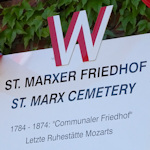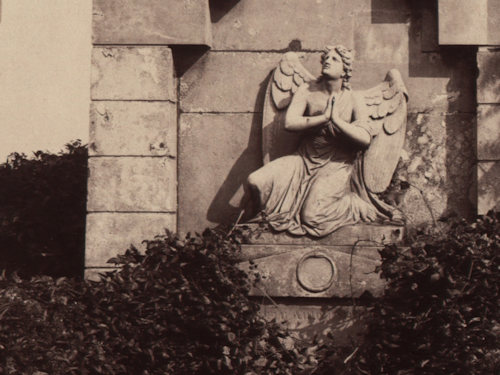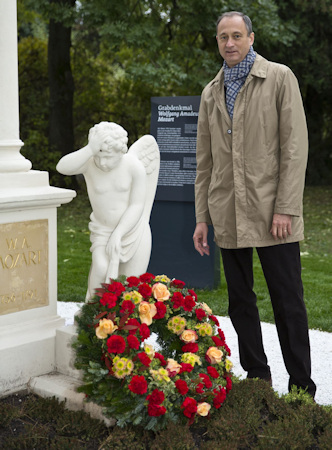
You wouldn’t normally think of a cemetery as a place of rest and relaxation, at least not for the living. But St. Marx Cemetery (German: St Marxer Friedhof) is different.
- Former cemetery and now a beautiful, atmospheric park
- They buried Mozart here in 1791
- A little off the beaten track
- Free to enter
- Book a historical walking tour* in Vienna
- See also:
A green oasis

(Gravestone at St. Marxer Friedhof around 1903; photograph by August Stauda, Wien Museum Inv.-Nr. 29258/5, Excerpt reproduced with permission under the terms of the CC0 licence)
St. Marx’s days as a working cemetery are far in the past, as it closed back in 1874. Nature has long since reclaimed the graveyard, leaving us with a combination of managed parkland and overgrown headstones with echoes of the gothic about them.
That description might sound a little menacing, conjuring up visions of skeletal remains rising in the night to moan about the tourists. Good luck getting a selfie with one of them.
Actually, the opposite is true.
St. Marx might best be thought of as a tranquil, green oasis full of trees, shrubs and flowers. Almost tranquil, I should say, since the nearby flyover means the distant drone of vehicles is ever-present.

(City councillor, Mr Mailath-Pokorny, at the newly-restored Mozart grave. Photo © PID / Georg Oberweger)
Nature has largely been left to sculpt her own tribute to the fallen, with ivy-clad gravestones and weeping angels poking their heads through garlands of green. Almost as if the headstones and plants grew up together.
A programme of restoration is underway, but I don’t think anyone wants them to hurry it up.
All of which would pass most people by were it not for the additional spiritual presence of one Wolfgang Amadeus Mozart: they buried the great composer here in 1791.
I say “spiritual presence” because they reused graves in those days, so Mozart’s mortal remains are presumably long gone.
My April visit to the park revealed great swathes of spring flowers and more buddleia than most of the rest of Vienna put together.
Benches tucked away in alleyways and small glades let you sit and listen to the constant chatter of birds and watch a cavalcade of insects skip past. I can only imagine the myriads of butterflies and bees that must appear as the sun grows in strength.
Most of the gravestones honour dignitaries and minor celebrities of the past, which won’t mean much if you’re not familiar with Viennese history. Composers, artists and architects. Actors and authors. Military men and business luminaries of the 18th and 19th centuries.
Mozart’s grave is really quite unusual for the location. It’s well-kept for a start, thanks to the city’s upkeep and restoration efforts. It also stands isolated from other graves and nature in a small island between two paths.
As such, St. Marx makes for one of the more poignant stops on any self-guided tour of Mozart locations in Vienna.
Tickets & visitor tips
The St. Marx cemetery park is free to enter and open every day of the year. At the time of writing, opening hours are 6.30am to 6.30pm (October to March) and 6.30am to 8pm (April to September), but gates may close up to 30 minutes early on occasion. Check the official website for the latest info.
Don’t plan to pop in here quickly in between visiting other sites: St. Marx remains relatively isolated from the main visitor areas in Vienna. So you need to set aside a little time to reach it (although fast and frequent trams take you out there).
One cemetery neighbour does, however, serve as a popular event venue: the Marx Halle hosts large trade fairs, but also concerts and consumer events like the Vienna Coffee Festival, the Edelstoff design markets, the Super Bier Fest, WeFair and 4GAMECHANGERS.
How to get to St. Marx cemetery
Tram: catch the 18 or 71 to St. Marx and follow the “St. Marx Friedhof” signs. Board the 71 in the centre (west side of the Ringstrassen or at Schwarzenbergplatz).
The 71 also takes you on to the Zentralfriedhof: a giant well-maintained cemetery with the graves of Beethoven, Schubert, Brahms, Strauss, Hedy Lamarr and many others of that ilk. Welcome to the city of music.
Bus: catch the 74A to Hoffmannsthalgasse and enjoy another short walk.
Address: Sankt Marx Cemetery, Leberstraße 6-8, 1030 Vienna